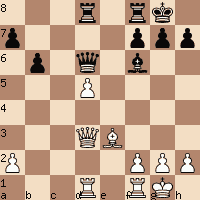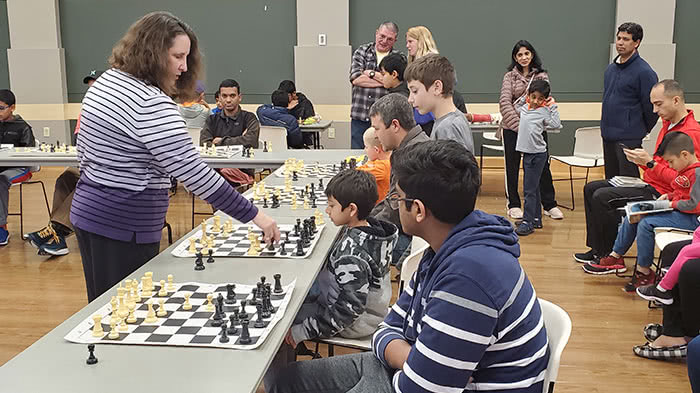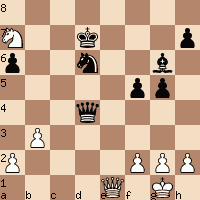On January 11, 2020, I gave my annual simultaneous chess exhibition at the Flower Mound Public Library. 77 people attended in this fourth year of the event, with 32 lined up and waiting at the door for the 2 p.m. start of the exhibition. I began by playing against 10 players. As players finished, they were replaced with the next names on the waiting list. Two hours later, I had played 20 games, finishing with 18 wins, one draw, and one loss.
20 games in two hours is a fast pace, meaning the average game took six minutes. I moved almost instantly when I arrived at each board. But sometimes my opponent was not ready to make a move, or had made an illegal move or an extra move, and that slowed down the exhibition’s pace.
US Chess (Chess Life Online) posted a press release giving details of the exhibition. Although not everyone got the chance to play me, spectators kept busy by playing each other on extra chess boards provided and watching the exhibition’s games.
Two of the first 10 people seated were a father and son. The son was only five years old, but played quite well. He developed his chessmen and castled, for example. The father was also a good player. I decided to offer him a draw in this position. I had White in every game.

My reasoning was that the position was probably equal. It was also a more challenging position than the positions that I had on my other nine boards, where I was material ahead and had clear winning plans. Also, by offering him a draw, a player from the waiting list could get a chance to play me. And, after the dad accepted my draw offer, he could then better supervise his five-year-old son. The son sometimes moved while I wasn’t at his board. When I arrived at the son’s board, he would play an additional move. I would be confused, and ask, “Did you play two moves in a row?” He would answer that he did, and he would take back one of the moves.
One rule of a simultaneous exhibition is to not make your move until the exhibitor is standing in front of your board, so the exhibitor can see your move. But the five-year-old son was a bit young to consistently follow that rule. I figured his dad could help him with keeping his hands off the board until I arrived for my next move.
I finally won a pawn against the five-year-old, and traded off pieces to get to a winning endgame. I am guessing we were around move 40 in this position. See if you can find my winning plan as White.

For drawing me, I gave the dad a copy of Chess Tactics Workbook for Kids, which I had reviewed for Texas Knights. I also gave away a copy of my book Prepare With Chess Strategy, as a prize to the one person, Esteban, who defeated me. Esteban joined the exhibition as a replacement for someone who lost among the first 10 players. Thus, my game with him was in the opening while most of my other games were in the middlegame or endgame stages. I didn’t play the opening well, lost a pawn, then played some questionable tactics and lost even more material. I resigned because I will be behind two minor pieces in the position shown, since my playing Qe3 does not save my knight because of ….Qd1+ which leads to checkmate..

Esteban was not a tournament player. Like several others at the exhibition, he didn’t know the en passant rule. But Esteban said that he is the best player at his workplace chess club, McKesson Medical-Surgical. I encouraged him to try local chess clubs or tournament chess, since he showed promise in his game against me.
